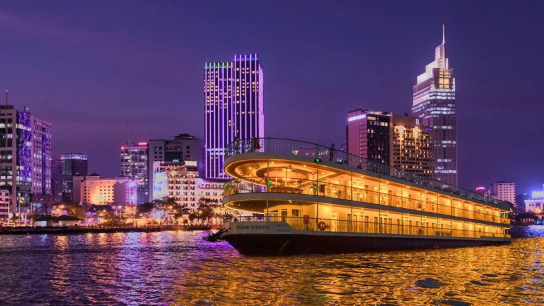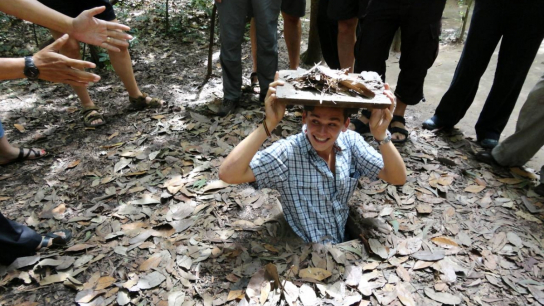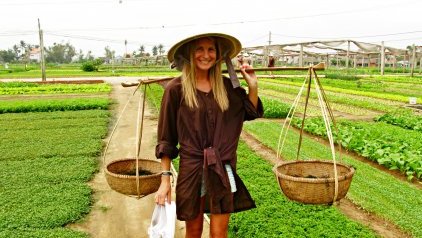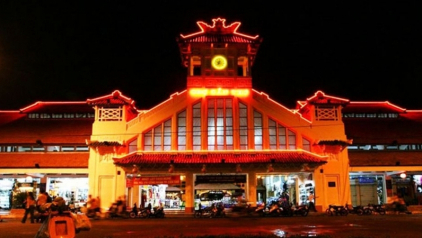Cholon: Chinatown Saigon - Where The Life Rapidly Flows
In districts 5 and 6 of Saigon, Hoa people, who originated from China, have for centuries settled down, creating the vibrant and flourishing Cho Lon.
Cholon Saigon, or Ho Chi Minh Chinatown, has been a stronghold for the Chinese-Vietnamese community since the late 1770s. Like other Chinatowns in the world, Cholon is the place where the majority of ethnically Chinese, or are descended from ethically Chinese people, live and trade.
The area is a bustling mix of old and new things, filled with temples, traditional shops, and markets as well as cool stores and cafes. The architecture is a fusion of Chinese tradition and French flair. Like a Russian doll, one elaborate roof begets another, smaller, while colonial France has dibs on the color scheme. The streets are narrow and maze-like, as with many densely populated, rapidly built, and re-built areas. Quite different from other districts, its congested streets and alleys are a great place to spend a few days wandering around. Its bi-lingual signs, special foods, ancient pagodas, and unique blend of culture give Cholon a very distinct feel and charm that local Vietnamese even find quite novel when they visit.

Street in Cholon - Saigon
Where is Cholon Saigon and how to get there?
Cholon is a huge area situated in District 5 and 6, on the Western bank of the Saigon River, bordered by Hung Vuong to the North, Nguyen Van Cu to the East, the Ben Nghe Chanel to the South, and Nguyen Thi Nho to the West.
As the area is just 6 km from district 1 and 8 km from Ho Chi Minh city center, getting here seems to be a piece of cake, even when you know nothing about the direction.
From your place in Saigon, you will have multiple choices to get to Cho Lon.
Traveling by bus is among those and can be the best way for budget travelers. Buses are due to depart from the spiritual construction (district 1) and arrive at Cho Lon station every 15 minutes from 5 am to 8.30 pm every day. By getting to Cho Lon in this way, you will have to spend 35 minutes and only $0.22 for the bus fare.
Besides, in such a situation after Covid-19, when public transports don't seem to be the best choice, you can opt for taxis or motorbike taxis. The advantage of this way is that you can grab a taxi or motorbike taxi anywhere in Saigon, and with a booking app on your smartphone, it is way more convenient. The fare will be more expensive than buses', about $2.20, but for a shorter route, which takes just 15 - 20 minutes.
The History of Cholon
The Chinese have been moving to Vietnam for centuries, leaving the country their heritage. In Cholon, the rich Chinese heritage has made it feel like a city within Saigon. The truth is, the area itself used to be a separate one.
In the late 18th, Chinese refugees took shelter here from the Tay Son forces, under the support of the Nguyen Dynasty. They lived, traded, and quickly created a large connected community, which then led to the area's being given the city status in 1865. By the 1930s, Cholon had expanded to the city limit of Saigon. Back in the old days, the place where Chinatown now sits was regarded as the city’s center of commerce, in comparison with District 1 – the center of administration nowadays. As urban spread enveloped the twin cities there were amalgamated into one city called Saigon-Cholon. In 1956, “Cholon” was dropped from the name and Saigon became the accepted title.
During the Vietnam War, many American soldiers and some deserters ran a thriving black market here. Afterward, due to some policies of the government, most of the Chinese left the area. Yet, it still retains its name as Cholon and Chinese heritage. Throughout the time, those living here now are no longer Chinese but Hoa people, an Vietnamese ethnic.
Meanings of the name "Cholon"
The name Cholon means "Big Market", in Chinese it is called Tai-Ngon which means embankment, but this name is hardly used by anyone else. In fact, there is little information about the name of Cholon. Some rumour has it that the name comes from the thriving time of Saigon Chinatown, when the area is the most marketplace in Vietname. People from other provinces and countries come here to live and trade things, creating a vibrant and lively atmosphere.
Where to visit in Saigon Cho Lon?
Walking around Cholon, it is also not difficult to spot traditional Chinese practices like shrines to earth gods outside homes, shops, and most obviously of all, Mandarin pop songs blasted from home entertainment systems. While many Buddhist pagodas in Vietnam take their styling cues from Chinese designs, those in Cholon are particularly special. They are the embodiment of Chinese cultural life as traditional religious and cultural events continue to be celebrated and commemorated.
Binh Tay Market

Binh Tay Market
While there are many markets within Cholon, Binh Tay is the central market – the largest and distribution hub for all things food and clothes in the area. Binh Tay Market is also one of the major markets in Saigon. It is quite similar to Saigon’s Ben Thanh Market, but it caters more towards local Vietnamese and Chinese shoppers, and less to tourists, so it has fewer souvenirs and more local Vietnamese products. You will find everything you can imagine within the market.
Lady Thien Hau Pagoda
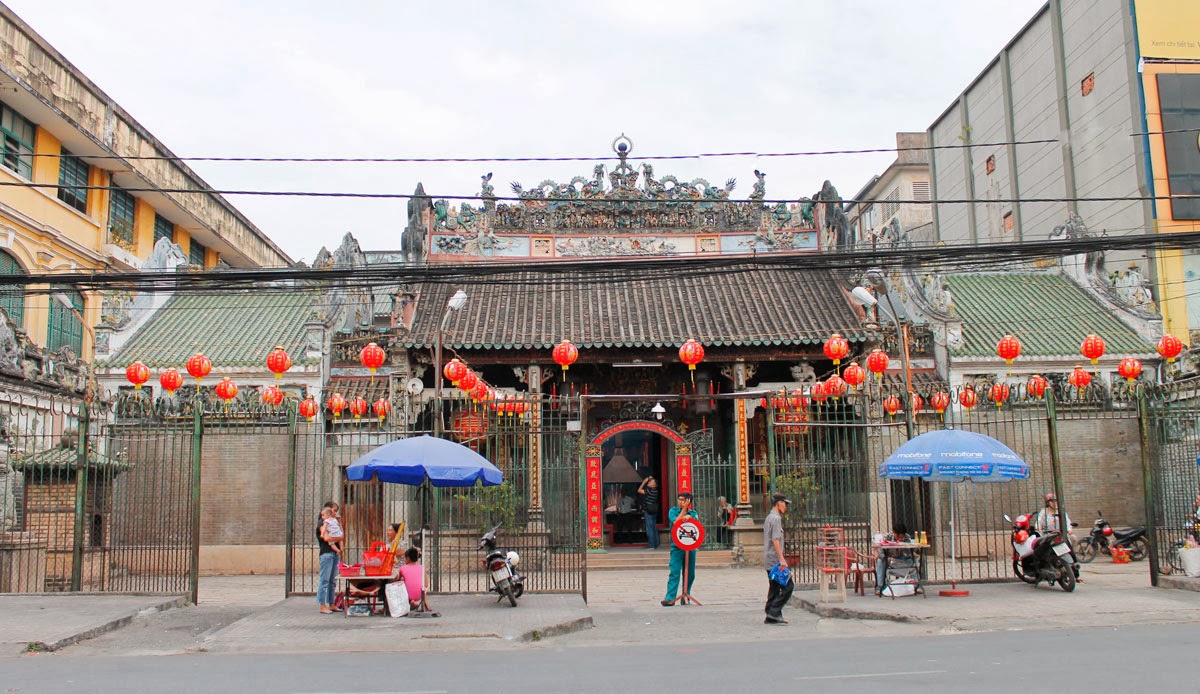
Lady Thien Hau Pagoda
The Lady Thien Hau Pagoda, one of the oldest temples of the Chinese community in Ho Chi Minh City, is located at 710 Nguyen Trai Street, District 5. It was built by a group of Chinese immigrants from Guangzhou in around 1760. It is dedicated to Lady Thien Hau, the Lady of the Sea. You will be impressed by the porcelain figurines that decorate the roof. Look at the details we may find many interesting things like the wedding custom and clothes in China in the late 19th century, or famous characters from "Travel to the West", or these demons probably related to the story about the Justice, the Hell, or the battle of General Guan Yu from the famous epic story "Three Kingdoms", or simply the scene from the routine life to the royal life in China at that time, or the Eight Immortals from Chinese mythology, etc.
Quan Am Pagoda (On Lang Pagoda)
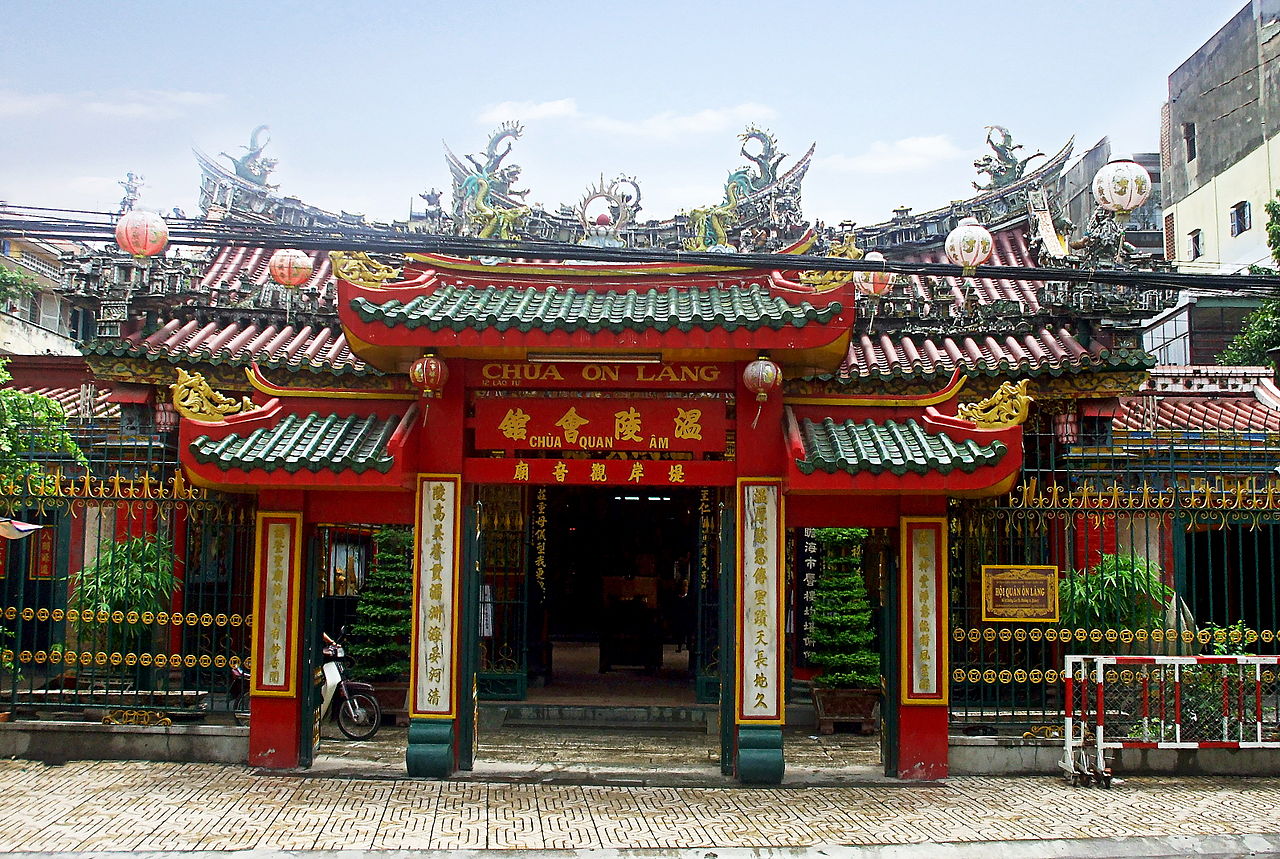
Quan Am Pagoda
Quan Am Pagoda is located on a tiny street, carefully hides in between small streets and food stalls. Founded in the early 19th century, the pagoda is named after the Goddess of Mercy. It is much smaller than the other temples you may find around town, and it has an almost cozy atmosphere. It is also one of the most colorful temples you could have seen! Fantastic lacquer representations of guardian spirits can be found at the entrance and superb ceramic scenes decorate the roof, depicting figures from traditional Chinese tales.
Nghia An Hoi Quan Pagoda
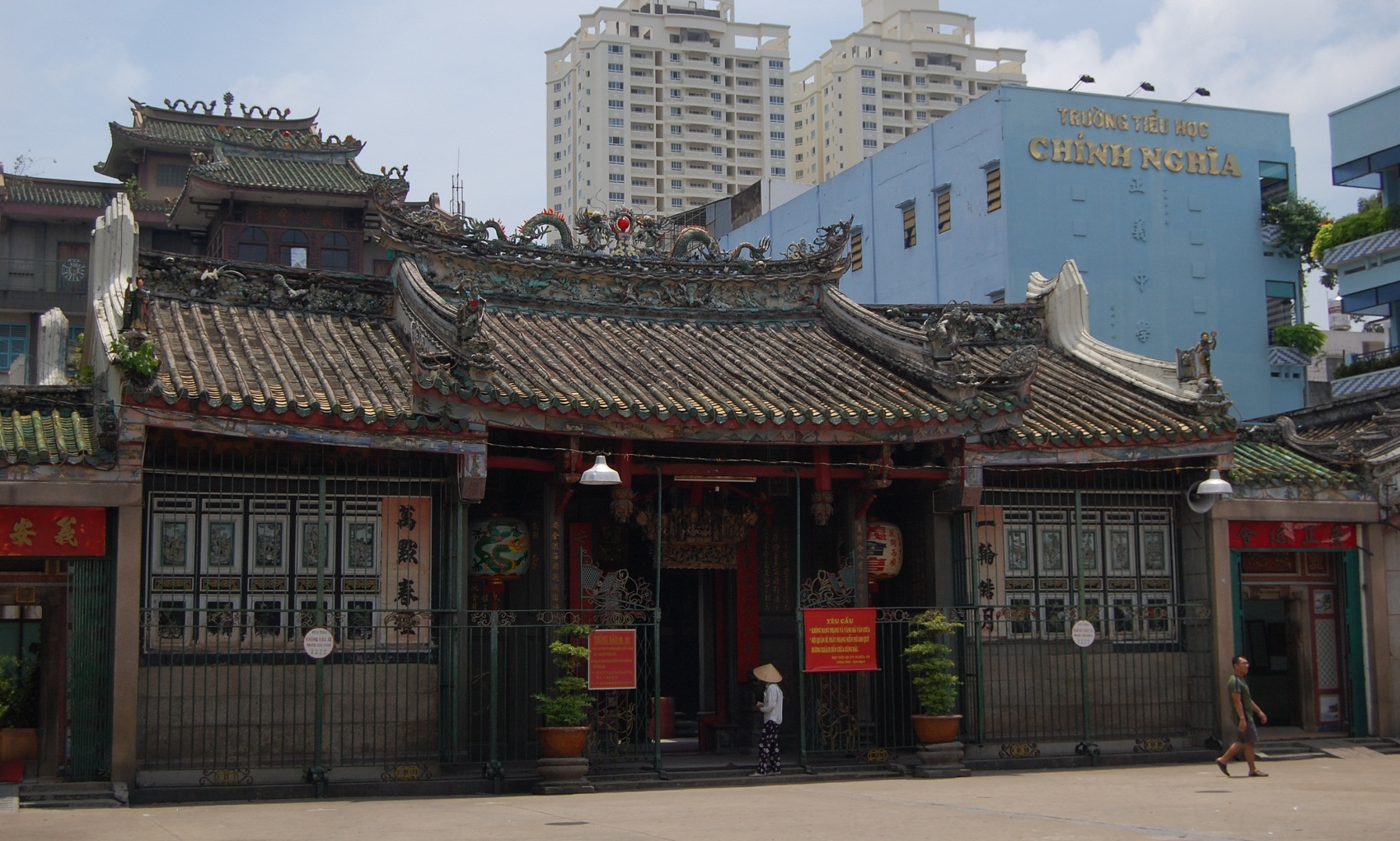
Nghia An Hoi Quan Pagoda
Nghia An Hoi Quan Pagoda is one of the oldest temples in Saigon, located at 678 Nguyen Trai Street. This pagoda was built in the 19th century by the Chaozhou Chinese population. It is dedicated to Guan Yu (also known as Quan Cong), a deified general who lived during the late Eastern Han Dynasty. The pagoda is noteworthy for its gilded woodwork: a carved wooden boat hangs over the entrance and to the left is a large representation of Quan Cong's horse and groom.
Cholon Mosque
Built in 1932 by the Vietnamese Tamil Muslims, Cholon Mosque now serves mainly Malaysian and Indonesian Muslims that settle down in Ho Chi Minh City. The mosque is a study in simple design, painted in soothing blues and greens, a beautiful contrast from the overwhelming rush of colors, scents, and sounds featured in other religious sites. While there are no Western guidebooks inside the mosque, English is spoken, and visitors of all faiths are welcome to drop by for a visit and marvel at the architecture.
Nhi Phu Temple
Ong Bon Pagoda or Nhi Phu Temple is the oldest Chinese pagoda in Saigon. It is also the only temple where Ong Bon, the initiator of the Chinese migration to Vietnam, is worshiped in the city. The highlights of this religious site include the beautiful Chinese characterized architecture, delicate exterior, and interior designs. The temple has played an important part in the life of the Hoa community in Saigon for hundreds of years.
Ha Chuong Guildhall (Ong Huoc Pagoda)
Founded in 1809, Ha Chuong Guildhall is closest in appearance to the southern Fujian style of temples seen across Taiwan. The formal name of this guildhall derives from an ancient term for Zhangzhou in southern Fujian. This is also primarily dedicated to Mazu, goddess of Seafarers who was born in Fujian. This Chinese pagoda in Cholon features four carved stone pillars, wrapped in painted dragons. They were made in China, brought by boat to Vietnam, and are now the main appeal of the guildhall. On each side of the main altar, there are attention-grabbing wall paintings and remarkable ceramic relief scenes on the roof. Besides, there’s quite an assortment of other shrines to be seen.
Minh Huong Pagoda (Phuoc An Guildhall)
In Cholon Saigon, Phuoc An Guildhall is less of a mystery than the others; this hall was constructed in 1902 to serve the immigrant community from Fu’an in northeast Fujian. The primary deity worshipped here is the red-faced general Guan Yu, but you’ll also find many other deities including Sūn Wù Kōng, the Monkey King from the 16th century Chinese classic Journey to the West. The most impressive thing is the beautiful ceramic murals inside this particular temple; this art form is more often seen on temple exteriors. Even the traditional tripodal censer is covered with fragments of porcelain! The stone guardian lions out front also seemed quite unconventional.
Tam Son Guildhall
Retaining much of its original rich ornamentation, this 19th-century temple – a guildhall named after Sanshan (Three Mountains) in China's seaboard Fujian province – is dedicated to Me Sanh, the Goddess of Fertility, entreated by local women praying for children. Thien Hau – the Goddess of Seafarers – is also revered within the main shrine. Among the striking figures is Quan Cong with his long black beard, to the right of the covered courtyard. Flanking him are two guardians, the Military Mandarin Chau Xuong on the left and the Administrative Mandarin Quan Binh on the right. Next to Chau Xuong is Quan Cong’s sacred red horse.
What to buy at Cholon
Coming to Cholon Saigon, you can easily combine exploring and shopping, as here there is Binh Tay central market. Though it is a wholesale market, Binh Tay also sells retail goods.
Popular items range from Vietnamese silk to lacquerware and hand-embroidered clothes to skillfully woven textiles. You can buy some as sounenirs as such products here are really stunning and sold at reasonable prices.
Besides, You will enjoy discovering many exotic items including delicious tropical fruits. Fruits sold in Binh Tay market are extremely fresh, clean, and sweeet. Also, like other products here, they are pretty cheap, so you can buy them in a large number for midnight snack or dessert after your day trying new food here.
In addition, outside Binh Tay market, there are many shops and stores that sell interesting things within the area of China town. As the main customers of these are the locals, prices will be not to high. Usually, with only $8.87 (200,000 VND), you can buy a lot of things.
Where and what to eat at Cholon Saigon?
"Chinese food, Japanese wife, and Western house", a saying in Saigon, expressed the three dreams of the old Saigonese, in which Chinese food was included, due to its delicious and unique taste.
In Cholon, Chinese food has been brought here by Hoa people, and throughout the time, changed to meet the Vietnamese taste. Therefore, it is said that Chinese food in Cholon Saigon is the perfect combination of Chinese heritage and Vietnamese features, thus even more worth trying. Here, there are some that you should never miss.
Hu Tieu Sate (Satay Noodle soup)
Hu Tieu Sate, the most popular food in Cholon, is the culinary heritage of authentic Chinese cuisine and several Indian traditional ingredients. The food was originated from Chaozhou, then followed the people's move to Vietnam. In Cholon, Hu Tieu Sate has many different versions such as Hu Tieu Sate Bo (Satay beef noodle soup), Hu Tieu Sate Suon (Satay noodle soup with pork ribs), and Hu Tieu Sate Nai (Satay venison noodle soup) but all offer a very good taste. The soft, chewy Hu Tieu noodle, dipped in the sweet-scented, greasy Satay soup, eaten with meat and vegetables will give you the full taste. A bowl of Hu Tieu Sate will cost you from $0.89 - $1.33 (20,000 - 30,000 VND). Some recommended restaurants in Cholon are Hu Tieu Sate Quang Ky, Hu Tieu Sate Nai To Ky gia truyen, Hu Tieu Sate Cao Van Lau, etc.
Mi Vit Tiem (Special Duck Egg Noodle Soup)
Cholon Saigon is called the kingdom of Mi Vit Tiem with a long line of restaurants serving the dish, so to find one seems a piece of cake for you. Mi Vit Tiem itself is made from ducks simmered with Chinese herbs known as the country's traditional medicine, to produce the broth, which will be used to boil noodles. A bowl of noodle soup consists of noodle, duck soup, duck, and vegetables. The noodle is chewy, the broth is scented, and the meat is soft, juicy. To try Mi Vit Tiem, you can come to Them Huy Mi Gia
Dimsum
Dimsum is the common name of Guangdong traditional cakes that are made from rice powder with topping inside and usually eaten for breakfast. Some popular dim sums include dumplings, baozi, and wonton. Originally, dim sum is steamed in a bamboo steamer but now they can be deep-fried or fried. When steamed, it is soft on the outside and sweet, juicy on the inside, while when deep-fried, the dim sum is hot, crusty. In Cholon, dim sum can be not only breakfast but also afternoon snacks. You can try dim sum at Baoz Dimsum, Dimsum Nguyen Tien Phat, Dimsum Tan Nguyen Thai, Dimsum nha lam, etc.
Tips for the best travel experience at Cholon Saigon
- To get to Ho Chi Minh Chinatown, taxi will be the best choice for you in such situation of Covid-19
- Have a Vietnamese friends keep you company on visiting several religious spots in Cholon
- Bring cashes along as paying by checks is quite rare here
- Wear casual clothes and shoes or sandals, as in Chinatown, you will have to walk a lot
Cholon has retained its Chinese identity and is a thriving hub of commerce and retail endeavor. All aspects of traditional Chinese culture have been preserved, combined with Vietnamese features and presents a truly amazing glimpse into a different world. Among the hustle and bustle life, being back to the ancient time and apreciating old values will be an off-the-beaten-track experience. So when you are in Saigon, try to include Cholon in your tour around the city. It might be the start of something special.
After finishing your trip in Saigon, why don't you take your time to travel to the Mekong Delta to explore many other interesting things. Check out at Mekong Delta tours.
Duc Anh Tran
Image source: Internet
